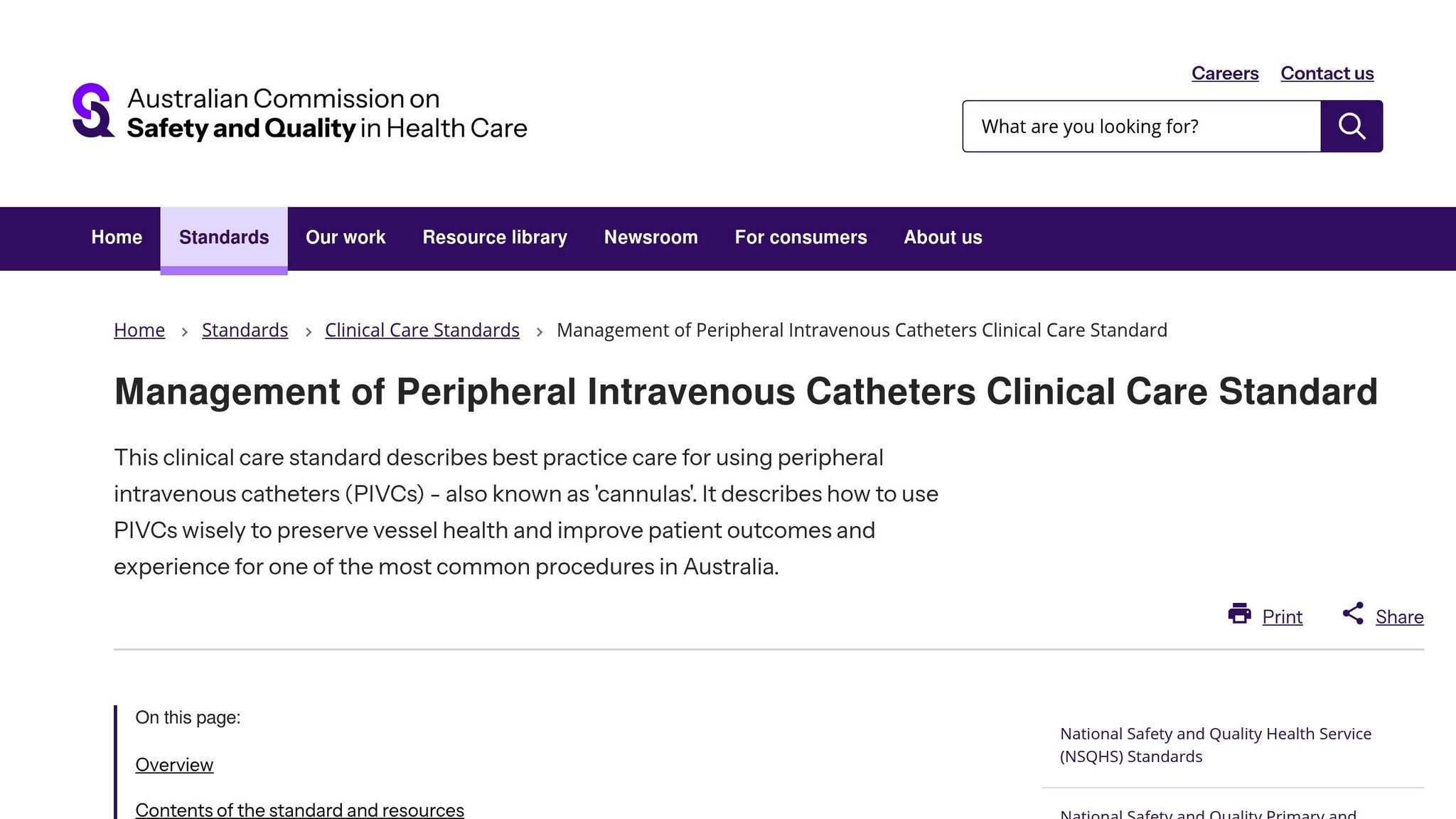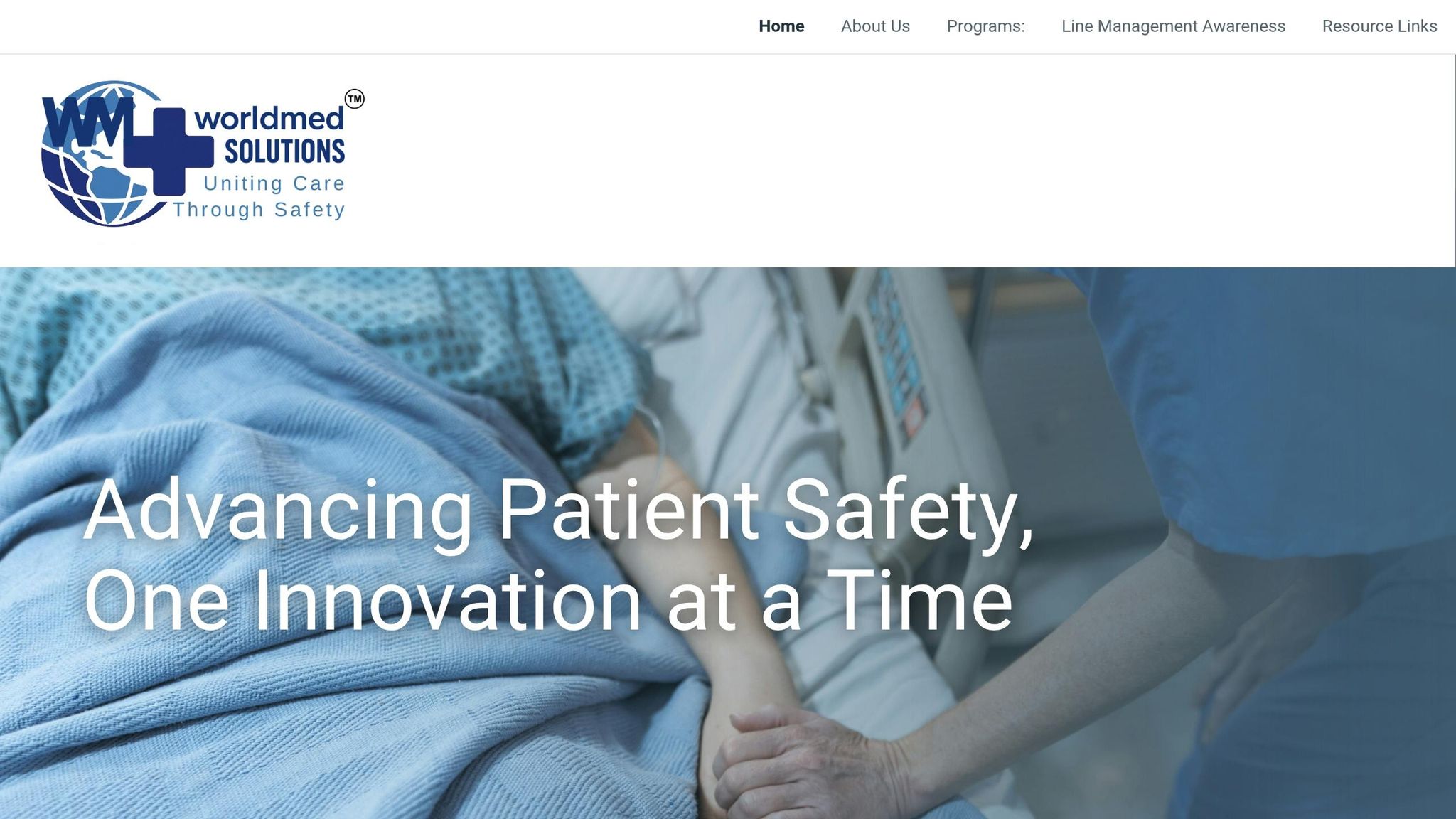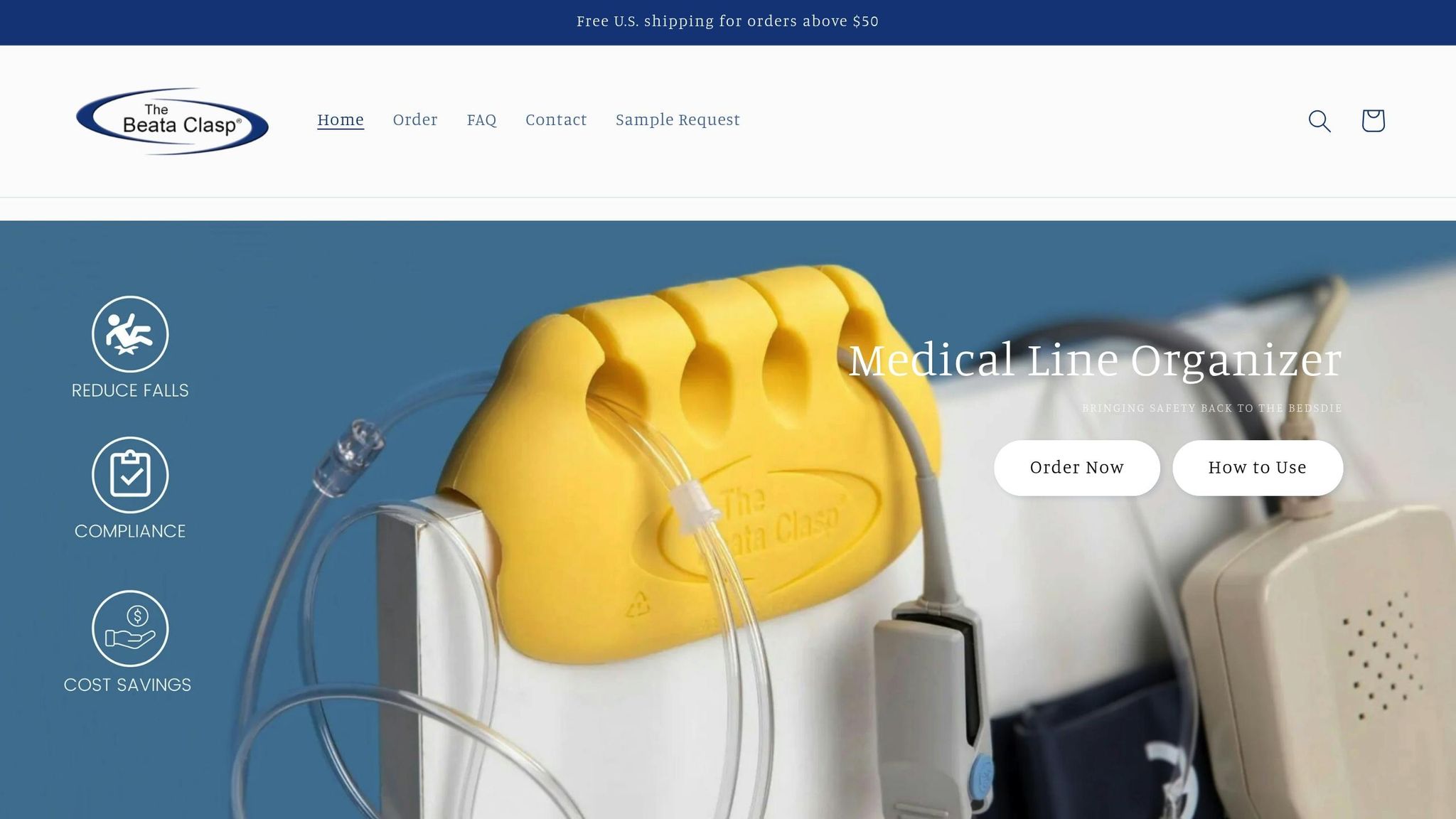Managing IV lines is a daily challenge for nurses, and disorganization can lead to serious risks like medication errors, infections, and workflow disruptions. WorldMed Solutions tackles these issues with standardized protocols and tools like the Beata Clasp, designed to simplify IV line management and improve patient care.
Key takeaways:
- Common problems: Tangled lines, contamination risks, medication errors, and delays in care.
- Solutions: Standardized protocols ensure consistency, safety, and efficiency in IV line management.
- Beata Clasp: A latex-free, antimicrobial tool that keeps IV lines organized, reduces contamination risks, and saves time.
Hospitals adopting these practices report improved safety, fewer errors, and smoother workflows, making standardized IV line management a smart move for better patient outcomes and reduced costs.
Improving the use of cannulas: Launch of the Peripheral Intravenous Catheters Clinical Care Standard

WorldMed Solutions: New Methods for IV Line Management

WorldMed Solutions is transforming how IV lines are managed by introducing standardized protocols. These protocols are designed to simplify nursing workflows and improve patient care through consistent and reliable practices.
WorldMed Solutions' Approach
The company employs well-defined procedures to minimize inconsistencies in IV line management. By streamlining these processes, they not only enhance efficiency but also ensure adherence to healthcare regulations in the U.S.
Aligning with U.S. Healthcare Standards
WorldMed Solutions has carefully developed its methods to align with established healthcare practices and regulatory requirements. This focus on standardization helps create a safer and more effective care environment for both patients and medical staff.
Case Studies: How Standard Line Management Works in Practice
Currently, there are no published case studies available on standardized IV line management within U.S. healthcare settings.
Improving Patient Safety and Reducing Risks
The goal of standardized IV line protocols is to boost patient safety while simplifying nurse workflows. By minimizing potential hazards and cutting down on delays during operations, these protocols hold the promise of creating a safer and more efficient healthcare environment. However, quantitative data to confirm these improvements is not yet available.
This focus on safety and efficiency lays the groundwork for tools like the Beata Clasp, designed to make IV line organization even more manageable.
sbb-itb-f779e18
Beata Clasp: A Tool for Organized IV Line Management

The Beata Clasp offers a practical solution for managing IV lines, addressing the daily challenges healthcare professionals face when dealing with multiple lines in busy clinical settings.
What the Beata Clasp Brings to the Table
Crafted from a soft, flexible material called styrenic thermoplastic elastomer (TES), the Beata Clasp is both lightweight and durable. Importantly, it’s latex-free, making it safe for individuals with latex allergies. The material also includes an antimicrobial additive, helping to curb the growth of bacteria and mold, which is especially critical in healthcare environments.
Its adaptable design allows it to fit various bedrails and medical equipment commonly found in U.S. hospitals. Each opening can hold tubing up to 5/8 inch in diameter, and the adjustable grooves are designed to secure multiple IV lines or smaller cords together.
The benefits of the Beata Clasp are clear: it keeps IV lines organized, reduces tangling, and saves time for nurses. By keeping lines off the floor, it helps lower contamination risks and ensures patient call lights remain accessible. Additionally, it minimizes the risk of misconnections, trips, and falls - key safety concerns in any healthcare setting.
The device is versatile, suitable for single-patient use or reusable after cleaning. Cleaning is straightforward and can be done using soap and water, bleach, or standard sanitizing wipes. However, it’s important to note that the Beata Clasp is not designed for autoclaving.
Pricing and Options for U.S. Facilities
Healthcare facilities in the U.S. can choose from three purchasing options, making it easier to adopt the Beata Clasp based on their specific needs and budgets:
| Option | Price | Best For | Key Benefits |
|---|---|---|---|
| Individual Unit | $19.95/unit | Small practices, pilot testing | A low-cost way to evaluate the product |
| Evaluation Pack | $163.00/pack (10 units) | Department-level testing | Cost-effective at $16.30 per unit, ideal for trials |
| Bulk Order | $467.50/pack (25 units) | Facility-wide implementation | Economical at $18.70 per unit for larger-scale use |
These pricing options provide flexibility for facilities of all sizes. Small practices can start with individual units, while larger departments might find the evaluation pack a cost-effective way to test the device’s impact. For facilities looking to standardize IV line management across multiple units, the bulk order option offers economies of scale.
With its reusable design and easy cleaning process, the Beata Clasp not only saves time for healthcare staff but also contributes to long-term cost savings. This tool is a practical investment for facilities aiming to improve efficiency and safety in IV line management.
Protocols and Methods for Standard IV Line Management
WorldMed Solutions has created protocols designed to streamline and standardize IV line management. These methods address the pressing need for consistency in patient care, focusing on systematic organization and prioritizing safety. By aligning with U.S. healthcare standards, these protocols aim to reduce medication errors, prevent line mix-ups, and lower the risk of contamination.
Step-by-Step Setup Guidelines
WorldMed Solutions' approach begins with thorough preparation and follows a structured process to ensure patient safety. The protocol combines core IV administration principles with enhanced organizational practices.
Here’s a streamlined process for setting up IV lines:
- Gather supplies: Collect all necessary items, including IV fluids, tubing, labels, and alcohol pads. Verify the orders using the eMAR/MAR system.
- Safety verification: Double-check the "six rights" of medication administration. Look for expiration dates, assess patient allergies, and inspect the IV solution bag for any signs of damage, leaks, or discoloration.
- Patient interaction: Perform hand hygiene upon entering the room, introduce yourself, confirm the patient’s identity using two identifiers, and explain the procedure to ensure understanding and comfort.
- Line setup: Use tools like the Beata Clasp to organize lines. Insert the spike into the IV bag tubing under sterile conditions, squeeze the drip chamber 2–3 times to fill it halfway, and prime the tubing over a sink. For multiple lines, invert the ports to prevent air bubbles.
- Final verification and monitoring: Conduct a final check of the "six rights" at the bedside. Once the IV is set up, continuously monitor the IV site and observe the patient’s response throughout the administration process.
By following these steps, healthcare providers can maintain a safety-first mindset, ensuring consistent and reliable IV line management.
(All steps are based on established IV administration guidelines.)
Conclusion: Better Patient Safety Through Standard Practices
WorldMed Solutions has introduced standardized IV line management protocols that significantly enhance patient safety across U.S. hospitals. These carefully designed methods tackle one of the most error-prone areas in healthcare - IV medication administration, which accounts for nearly 40% of medical errors.
Hospitals implementing practices like the Aseptic Non-Touch Technique have seen remarkable results. For instance, healthcare-associated infections dropped by 70%, catheter patency improved by 22%, and overall infection rates decreased by 17%. These protocols are not just about numbers; they bring meaningful changes to daily clinical workflows.
By organizing IV lines systematically, these protocols address critical issues such as infusion rate errors and line mix-ups, particularly with high-alert medications. Tools like the Beata Clasp further simplify line identification, creating a safer environment for both patients and healthcare providers. This shift in practice also lightens the workload for nurses, allowing them to focus more on patient care. Streamlined workflows save time, reduce stress, and lead to more consistent, reliable care delivery.
For U.S. healthcare facilities looking to boost patient safety while improving operational efficiency, adopting these standardized IV line management practices provides a clear, effective solution. These protocols demonstrate how structured systems, combined with proper tools and verification processes, can create a safer and more efficient healthcare environment.
FAQs
How does the Beata Clasp help prevent IV line contamination and medication errors?
The Beata Clasp enhances IV line management by keeping lines tidy and elevated, reducing the likelihood of contamination or tangling. This streamlined organization not only helps prevent accidental disconnections but also makes it easier to trace individual lines, lowering the risk of medication errors. By promoting a clean and orderly setup, the Beata Clasp contributes to safer and more efficient patient care.
What are the key benefits of using standardized protocols for IV line management in healthcare settings?
Using standardized IV line management protocols brings a host of benefits to healthcare facilities. One of the most critical advantages is improved patient safety. By minimizing the risk of infections, complications, and errors related to IV lines, these protocols play a key role in protecting patients. Research even shows that following these protocols can reduce adverse events by up to 29%, leading to more positive patient outcomes.
Another major benefit is increased efficiency. Standardized processes cut down on unnecessary venipuncture attempts and save valuable staff time, allowing healthcare teams to focus on delivering consistent, high-quality care. This approach not only streamlines workflows but also reinforces a culture of safety, where best practices become second nature. Plus, standardized protocols simplify staff training and reduce inconsistencies in care, helping to prevent issues like line mix-ups or improper handling.
What training or guidelines are available to help healthcare staff use the Beata Clasp and follow standardized protocols effectively?
To make the most of the Beata Clasp and follow established protocols, healthcare staff should engage in thorough training programs. These programs include hands-on practice, clear instructions for adhering to CDC safety guidelines, and routine compliance checks through audits.
The Beata Clasp also provides staff with educational materials, quick-reference guides, and tools to help organize and simplify its use in clinical settings. These resources are designed to seamlessly fit into existing workflows, ensuring patient safety and improving overall efficiency.
